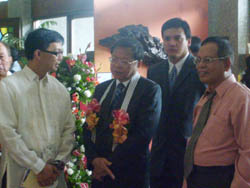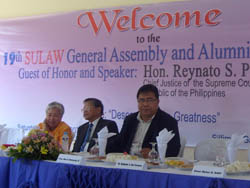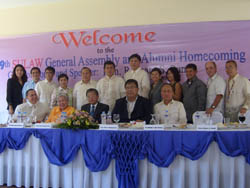
First, allow me to thank Silliman University for inviting me to address this University Convocation on the occasion of its 106th founding anniversary. I also congratulate Dr. Rolando V. Carmen for receiving his rare award. Lando is a good friend whose footsteps I have followed. When he attended the Southern Methodist University Law School of Dallas, Texas, to take up the Master of Comparative Law degree in 1964, I followed him a year after; when he enrolled at the University of California Law School, Berkeley, California, to pursue the Master of Law degree in 1965, I did the same the following year; when he went to the University of Illinois Law School at Champagne, Urbana, to get the Doctor of Juridical Science degree in 1966, I followed him the following year. Dr. Carmen is a legal scholar worthy of note in the United States. His book on Criminal Procedure is a bestseller in the United States with a long shelf life. It is now in its 8th edition, and I always consult it to find the latest wrinkle in American jurisprudence on criminal procedure.
 Chief Justice Reynato Puno with Salonga Center Director Atty. Mikhail Maxino and Judge Rosendo Bandal of RTC Branch 34 at the Luce Auditorium lobby
Chief Justice Reynato Puno with Salonga Center Director Atty. Mikhail Maxino and Judge Rosendo Bandal of RTC Branch 34 at the Luce Auditorium lobby
Second, I wish to beg your dispensation for changing the topic of my message this morning. I was originally requested to deliver a disquisition on the theme Descending into Greatness. Considering the holy mystery embedded in the theme, I thought I would rather expostulate on it tomorrow when I to preach in the divine morning worship service. And so, allow me instead to talk about the march of human rights in the world and in the Philippines. Hopefully, we can appreciate how well we are addressing our human rights problems in comparison with the rest of the world.
I. The Evolution of Generations of Human Rights
I wish to start with the evolution of human rights. The first generation of human rights is in the form of individual and civil rights. These are rights essential to human nature or that inhere in all human beings as humans. Espoused as natural laws by the ancient Greeks at the beginning of the 18th century, these rights were limited to personal liberty, equality before the law, and the protection of property. The American Bill of Rights added freedom of religion, freedom of speech and of the press, right to peaceably assemble, and due process. In the 20th century, political rights were further expanded to include the right to vote, among others. The second generation of human rights refers to social, economic and cultural rights. Among the rights included are the right to education, the right to health care, the right to strike, the right to bargain collectively, the right to work, and the right to cultural heritage. These rights bloomed as an aftermath of the Industrial Revolution in Europe.
In the past decades, a third generation of human rights has come into being. These partake of the nature of collective rights, like the right to have a healthy environment, the right to development, and the rights of indigenous communities. They are the offshoots of globalization.
There is a fourth generation of human rights still in the process of developing. I refer to the protection of the human genome and of genetic identity, as well as the rights that flow from informatics technology. They are the result of the ongoing revolution of knowledge.
II. The Internationalization of Human Rights
 Let me now go to the development of human rights, known as the internationalization of Human Rights.
Let me now go to the development of human rights, known as the internationalization of Human Rights.
Chief Justice Reynato Puno with Silliman University Board of Trustees Chair Prof. Leonor Briones and SU President Dr. Ben Malayang during the 19th SULAW Assembly held right after the University Convocation
Until the Second World War, the roots of human rights grew country by country. The growth was necessarily uneven, for the seeds of human rights sprout on different grounds differently. Some grounds were more suited than the others, considering the readiness of their people’s culture and experience. At this stage, the protection of human rights depended largely on the will and pleasure of the sovereign ruler of each country. The horrors of the Holocaust, however, shattered this dependency, for Hitler showed to the world that the States themselves could be the predators of human rights. Hence, in the second half of the 20th century, human rights became a concern, not only of national law, but of international law. This internationalization of Human Rights started in 1948, with the United Nations Universal Declaration of Human Rights and the American Declaration of the Rights and Duties of Man drafted by the Organization of American States. Two years later, or in 1950, the first multilateral treaty on human rights – the European Convention on Human Rights – burst into being. In 1966, the UN adopted two international covenants: one involving civil and political rights; and the other involving economic, social and cultural rights.
A most significant part of the International Covenant on Civil and Political Rights is its imposition upon the signatory States, which includes the Philippines, the duty to adopt the necessary laws to give effect to the rights enumerated in the covenant. Articles 2 and 3 mandated the signatory States –
(a) to ensure that persons whose rights or freedoms x x x x are violated shall have an effective remedy, even if the violation has been committed by those acting in an official capacity;
(b) to ensure that persons claiming such a remedy shall have their rights thereto determined by competent judicial, administrative or legislative authorities, or by any other competent authority provided by the legal system of the State, and to develop the possibilities of a judicial remedy; and
(c) to ensure that when granted, the competent authorities shall enforce such remedies.
Complementing the movement towards the internationalization of human rights was the broadening of the scope to include those responsible for their violation. Originally, human rights were protected only from violations by the State; hence, in international covenants, the bearer of the duty was always the state. In other words, the right of an individual citizen is not protected from an unlawful act or omission by another individual, but only from State intrusion. There was a right to sue, but only against the State.
Stated otherwise, the internationalization of rights resulted in a change of concepts as to the holders of the right and the bearers of the duties or the personalities of those who could sue and who could be sued. Take for instance, the third-generation human rights, which include the right to a healthy environment. This right does not belong only to an individual; it belongs to the entire populace and can be claimed even by the international community. Correspondingly, the duty to preserve a healthy environment is demandable by the people as a collectivity against a State, an individual, a group, or a community. Pollution, for example, prejudices individuals, communities, and the State; its ill-effects could even cross over to other countries. For these reasons, the irreversible trend now is to hold both the State and individuals accountable for violation of international human rights.
III. The Constitutionalization of International Human Rights
 Chief Justice Reynato Puno with some of the faculty members of the Silliman University College of Law at the Business Administration Assembly Hall
Chief Justice Reynato Puno with some of the faculty members of the Silliman University College of Law at the Business Administration Assembly Hall
After internationalization comes the stage known as the constitutionalization of international human rights in the fundamental laws of individual countries. Constitutionalization means the incorporation of international systems of protecting human rights into a country’s Constitution. Again, the importance given to international instruments protecting human rights varies from country to country. By importance is meant the priority given to these international instruments with respect to their enforceability in a particular country; more specifically, whether they are accorded the same rank as the Constitution or as an ordinary law. A quick survey of comparative constitutional law, both in common law and civil law countries, will reveal that international instruments protecting human rights are accorded four different ranks. Some countries give them a supra-constitutional rank, meaning a rank superior to the Constitution itself. Thus, the 1999 Constitution of Venezuela, in its Article 23, provides – Treaties, covenants and conventions referring to human rights, signed and ratified by Venezuela, shall have constitutional hierarchy and will prevail over internal legal order, when they contain regulations regarding their enjoyment and exercise more favorable than those established in this Constitution and the statutes of the Republic. Similar provisions can be found in the Constitutions of Colombia, Guatemala, and Honduras. Resultantly, their courts have given to their citizens rights contained in the American Declaration of the Rights and Duties of Man approved by the Organization of American States, even when these rights are not specifically recognized in their Constitutions.
A second group of countries gives international instruments protecting human rights the same rank as their Constitution, meaning a rank at par with their Constitution. Article 4 of the Constitution of Panama, for example, provides that it shall respect the norms of international law. This provision enables its Supreme Court to strike down as unconstitutional any law infringing the guarantees of international treaties on human rights their countries have ratified.
A third group of countries gives international instruments protecting human rights a rank inferior to the Constitution but superior to ordinary laws. Article 7 of the Constitution of Costa Rica, for example, provides that “public treaties, international agreements and covenants duly approved by the Legislative Assembly shall . . . have superior authority to that of the laws.” Germany, France, and Italy also grant a rank to international treaties on human rights superior to their statutes.
A fourth group of countries gives to these international treaties a rank that is at par with the laws of Congress or the Parliament. Most countries follow this approach. Their Constitutions provide that “international law is part of the law of the land.” The leading exponent of this approach is the United States, and the Philippines follows this approach.
IV. Judicial Protection of Human Rights
Let me now discuss how human rights are protected by courts all over the world.
Two systems of judicial remedies are available abroad. The first system follows the Anglo-American model. Under this model, constitutional rights are judicially protected by a resort to ordinary or extraordinary remedies provided by law or by equity. The most common legal remedies are damage remedies, restitution remedies, and declaratory remedies. The most common equitable remedy is injunction.
Authors Tabb and Shoben classify four kinds of injunction used to protect constitutional rights, viz: First, the preventive injunctions, in the sense of avoiding harm, as a court order designed to avoid future harm to a party by prohibiting or mandating certain behavior by another party, that is, to prevent the defendant from inflicting future injury to the plaintiff. Within these preventive injunctions, it is possible to distinguish the mandatory injunctions, like the writ of mandamus; the prohibitory injunctions, like the writ of prohibition; or the quia-timed injunctions. All these injunctions can be permanent injunctions that affect the legal relationship of the parties until subsequently modified or dissolved.
Second, the structural injunctions, developed by the courts after the Brown v. Board of Education case (347 U.S. 483 [1954]; 349 U.S. 294 [1955]), in which the United States Supreme Court declared the dual school system discriminatory, using injunction as an instrument of reform, by means of which the courts in certain cases undertake the supervision over institutional State policies and practices in order to prevent discrimination.
Third, the restorative injunctions, also called reparative injunctions, devoted to correct a past wrong situation.
And fourth, the prophylactic injunctions, issued also to safeguard the plaintiff’s rights, preventing future harm, by ordering certain behaviors from the defendant, other than the direct prohibition of future actions. The most important of all these injunctions, when referred to the protection of rights, are the preventive injunctions (whether mandatory or prohibitory), and the restorative ones.
Aside from injunction, the other extraordinary Anglo-Saxon remedy to protect life and liberty is the writ of habeas corpus. It is used to challenge the legality of a person’s detention. In fine, the protection of rights, both constitutional and nonconstitutional, is assured through general law and equitable remedies. No specific remedies have been designed to safeguard these rights. We follow the Anglo-American system.
Under the second system, followed in Latin American countries, aside from the usual judicial remedies to protect constitutional rights, there are three specific writs designed for the purpose. Available in their courts are the following special writs that seek to protect constitutional rights and to prevent their violation: (1) the writ of habeas corpus, (2) the writ of amparo, and (3) the writ of habeas data.
I will not tarry long with the writ of habeas corpus, for most of us are familiar with its scope and limitation. Let me proceed to the writ of amparo. The writ of amparo originated in the 1857 Constitution of Mexico. It started as a protection against acts or omissions of public authorities in violation of constitutional rights. Later, however, the writ evolved for other purposes. Thus, today, it is used –
(1) For the protection of personal freedom, equivalent to the habeas corpus writ (called amparo libertad);
(2) For the judicial review of the constitutionality of statutes (called amparo contra leyes);
(3) For the judicial review of the Constitutionality and legality of a judicial decision (called amparo casacion);
(4) For the judicial review of administrative actions (called amparo administrativo); and
(5) For the protection of peasants’ rights derived from the agrarian reform process (called amparo agrario).
The writ of amparo has been adopted by Latin American countries, except Cuba, to protect human rights against abuses especially during the time they were governed by military juntas.
There is a third writ, the writ of habeas data. Its literal translation from Latin is “you should have the data.” It shows variations from country to country in Latin America but in general, it is a remedy to protect the image, privacy, and honor of an individual and to enforce the freedom of information of a person.
The remedy of habeas data can be used by any citizen against any governmental agency or register to find out what information is held about his or her person. That person can request the rectification or even the destruction of erroneous data gathered and kept against him.
In a landmark case in Argentina, its Supreme Court ruled that the remedy of habeas data can be resorted to by the families of the deceased.
This opened the door to families of the “disappeared” to demand access to police and military files otherwise closed to them.
The writ of habeas data is relatively new but its origins can be traced to certain European legal mechanisms that protected individual privacy.
This is not a surprise, as Europe is the birthplace of modern data protection.
In particular, certain German constitutional rights can be identified as the direct progenitors of the writ of habeas data. The right to information self-determination was created by the German Constitutional Tribunal by an interpretation of the existing rights of human dignity and personality. This is the right to know what types of data about an individual are stored on manual and automatic databases, and it demands that there must be transparency on the gathering and processing of such data. The other direct predecessor of the writ of habeas data is the Council of Europe’s 108th Convention on Data Protection of 1981. The purpose of the convention is to secure the privacy of the individual regarding the automated processing of personal data. To achieve this, several rights are given to the individual, including the right to access their personal data as held in an automated database.
The first country to implement the writ of habeas data is the Federal Republic of Brazil. In 1988, the Brazilian legislature voted for a new Constitution, which included a novel right – – – the habeas data individual complaint which is now guaranteed as a full constitutional right.
Following the Brazilian example, Colombia incorporated the habeas data right to its new Constitution in 1991. Afterwards, many countries followed suit and adopted the new legal tool in their respective Constitutions: Paraguay in 1992, Peru in 1993, Argentina in 1994, and Ecuador in 1996.
The writ of habeas data is proving to be of great importance to relatives of victims of human rights violations, for it gives them the right to truth in their search for the fate and whereabouts of those who have disappeared as a result of the illegal acts and omissions of public authorities.
V. The Philippine Situation
I took pains to narrate the development and protection of human rights in the world to show how the Philippines is faring in that regard. Looking at our record with the most hospitable eye, the conclusion will not be kind to our authorities. The number of victims of extrajudicial killings and involuntary disappearances is already chilling as it is, and we are still counting. This bulging number of victims of human rights violations and the failure to bring the perpetrators to swift justice have brought to us what observers derisively call a culture of impunity.
Indeed, the human rights situation in the Philippines has alarmed the international community. Human rights advocates from the United Nations, the European Union, and the United States have decried that the Philippines is fast gaining the reputation as the graveyard of human rights in Asia. But the business of protecting human rights in the Philippines is the business of Filipinos, more than the business of foreigners. Let me submit, however, that as Filipinos, let us not forget that we have a glorious history of protecting human rights in our shores and of advancing their frontiers elsewhere in the world. Nobody can dispute the fact that Rizal, Mabini, Del Pilar, and our other national heroes established the first democracy in Asia.
Nobody can dissolve the truth that the Philippine delegation to the United Nations, led by the well regarded Carlos P. Romulo, played a significant role in the drafting of the Universal Declaration of Human Rights. Nobody can wink away the fact that in 1986, the Filipinos put an end to a homegrown authoritarianism through a revolution bereft of bullets and bombs. I respectfully submit further that the framers of the 1987 Constitution were gifted with a foresight that allowed them to see that the dark forces of human rights violators would revisit our country and wreak havoc on the rights of our people. With this all-seeing eye, they embedded in our 1987 Constitution a new power and vested it on our Supreme Court – the power to promulgate rules to protect the constitutional rights of our people. This is a radical departure from our 1935 and 1972 Constitutions, for the power to promulgate rules or laws to protect the constitutional rights of our people is essentially a legislative power, and yet it was given to the judiciary, more specifically to the Supreme Court. If this is disconcerting to foreign constitutional experts who embrace the tenet that separation of powers is the cornerstone of democracy, it is not so to Filipinos who survived the authoritarian years, 1971 to 1986. Those were the winter years of human rights in the Philippines. They taught us the lesson that in the fight for human rights, it is the judiciary that is our last bulwark of defense; hence, the people entrusted to the Supreme Court this right to promulgate rules protecting their constitutional rights.
It is for this reason that last month, the Supreme Court called for a national Summit in search of solutions to our rampaging extralegal killings and enforced disappearances. I am happy to report to you that since that Summit, we have been continuously working on the rules to govern the use of the writ of amparo to protect the constitutional rights of our people. As envisaged, the writ of amparo will deny to the authorities the defense of simple denial when they are sued to produce, before the courts, the bodies of victims of involuntary disappearances. The writ will hold public authorities to a high standard of official conduct, failing which they will be held accountable to our people. After the writ of amparo, we are also contemplating on promulgating rules to govern the issuance of the writ of habeas data, the remedy that will give reality to the right to truth of our people. The exercise of the right to truth will expose all the falsehoods, all the fabrications that public authorities and private persons usually put up to evade responsibility in cases of extralegal killings and involuntary disappearances. We are hopeful that the three writs – the writ of habeas corpus, the writ of amparo, and the writ of habeas data – which solved the problem of extralegal killings and enforced disappearances in Latin American countries under military dictatorships will serve the same purpose in the Philippines. These writs are our humble offering to our people, to show our gratitude for their trust and confidence; and we will demonstrate this fidelity to the human rights of the Filipino, not with a brittle wishbone, but with an unbending backbone.
Let me conclude with the memorable prose of Prof. Lewis Henkin of Columbia Law School. He said: “The Universal Declaration of Human Rights has become the holy writ to which all pay homage, even if sometimes the homage of hypocrisy.” I wholeheartedly agree with Prof. Henkin, and let me add that we in the judiciary understand the physics of the fate of the victims of extralegal killings and involuntary disappearances; and, hence, in the protection of their right to life and right to liberty, there will be no dissonance between rhetoric and reality in our courts of justice. To quote a poet, “Knowing is not enough; we must apply. Willing is not enough; we must do.”
Thank you and God bless us all.
* Delivered by Chief Justice Reynato S. Puno on 25 August 2007 at the Luce Auditorium, Silliman University, Dumaguete City, during its University Convocation and Presentation of the 2007 Outstanding Silliman University Law Alumni Association (SULAW) Award to Prof. Rolando V. del Carmen and 19th SULAW General Assembly and Alumni Homecoming. The Chief Justice, on the same occasion, was likewise conferred an Honorary Membership in the SULAW.

